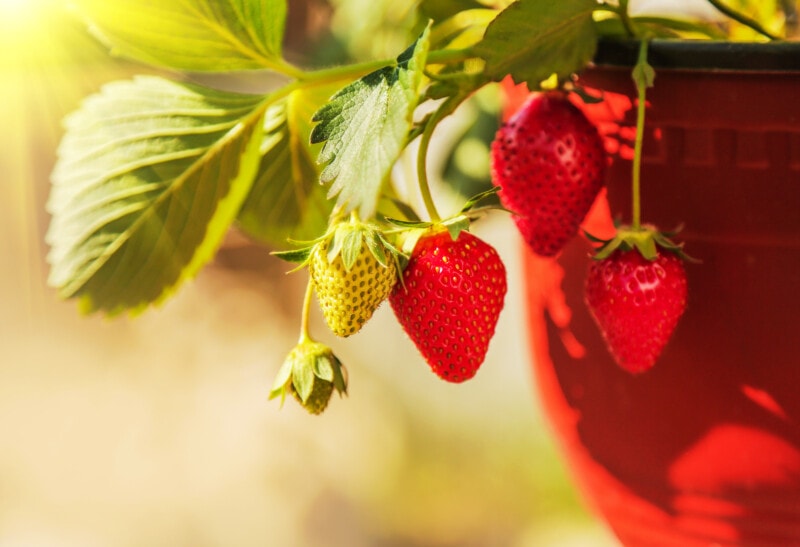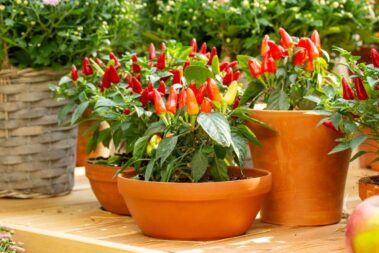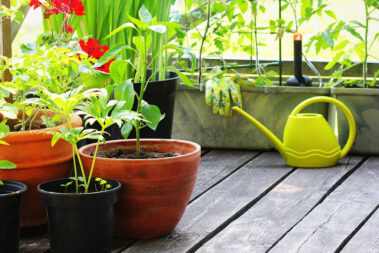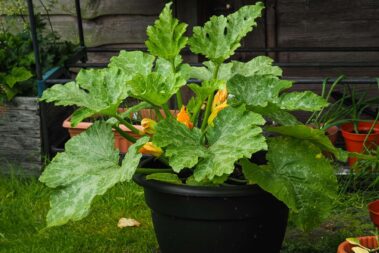Strawberry plants are one of the easiest fruits to grow in your backyard garden bed. But a better solution for growing this space-hogging berry is to plant them in pots.
Below, we’ll show you how to grow strawberries in pots and maximize your harvest in 8 simple steps.
Table of Contents
8 Steps for Growing Strawberries in Containers
Some crops are just as easy to grow in pots as they are in the ground. And some, even more so (I’m looking at you cherry tomatoes!). Unfortunately, strawberries do not fall into either of these categories. If you want them to grow well in pots, you have to get things just right.
1. Choose Your Location
Strawberries like it sunny, preferring 8 to 12 hours of sun per day. But they also don’t like to get too warm—which poses a problem for growing them in containers.
If you live in a mild climate, then set your strawberry containers on a south-facing porch or patio. If you get more extreme heat or have to deal with high-altitude sunlight, you’re better off finding a bright east-facing location. You may even consider starting the plants out facing south and rotating them to a place with less afternoon sun as the season warms up.
2. Choose the Right Containers and Soil
While strawberry leaves are fairly tolerant of the heat, the roots are not. This is a problem for growing strawberries in pots because the soil gets so much warmer than it would in the ground. To combat this, make sure you choose a strawberry pot that is light in color to reflect some of the sunlight.
You should also assure your containers have plenty of drainage holes. Pots with one large drainage hole in the center or only a couple small holes aren’t adequate. If the pot is plastic or metal, you can add extra holes using a drill.
Strawberry plants have shallow roots, so a deep pot isn’t necessary, but they do like their space so opt for wide containers. In terms of soil, fill the pots with loamy potting soil that will hold moisture without getting boggy.
3. Choose Your Starter Plants
First, you need to decide what type of strawberries you want to grow. June-bearing strawberry varieties fruit once in mid-June, while ever-bearing varieties fruit throughout the summer. The last option, day-neutral strawberries, produce large crops of berries three times throughout the summer.
Starting strawberries from seed is a long, difficult process and not recommended unless you are a very patient person. Instead, opt for buying transplants or crowns from your local nursery.
Crowns are dormant stems with root balls that are harvested from the runners of mature plants. These should be planted early in the spring after the last hard freeze. Transplants can be started anytime from early to late spring. Plant up to three plants per square foot of surface area.
4. Water and Feed Often
Water frequently enough through the spring to keep the soil moist without overdoing it. In the summer you’ll want to give your plants less water at a time, but water more often, up to multiple times per day. This will help keep your strawberry roots cool without oversaturating the soil.
Strawberries in pots need to be fertilized about every three weeks using a conventional 10-10-10 liquid fertilizer.
5. Snip the Runners
If you are growing strawberries as ornamental plants, then by all means let the runners drape over the sides of the container. But if you’re growing them for the fruit, you’ll want to snip any runners that appear. This will help the plant conserve energy for fruit growth and increase your yield substantially.
6. Protect Your Fruit
One good thing about growing strawberries in containers is that they are less vulnerable to bugs and animals. But you still need to take some steps to protect them.
If you do find that slugs and other bugs are feeding on your strawberries, add some cedar mulch to the top of the soil. If the birds have discovered your crop, use garden netting to keep them away from your berries.
7. Harvest and Enjoy
Depending on what variety of strawberry you grow, you may just get one harvest or many throughout the summer. Pick the berries once they have turned completely red by cutting the stem just above the fruit.
Fresh strawberries are perfect for making homemade chocolate covered strawberries and delicious fruit tarts.
8. Winterize Your Plants for Next Year
Whether you choose alpine strawberries, June-bearing varieties, or day-neutral plants, all will stop producing fruit as the whether cools. With the right care, they can also all survive the winter to produce again the following year.
In late August, give your strawberries one last good round of fertilizer (about ⅓ cup of conventional fertilizer per square foot). This will give your container plants the nutrients they need to set plenty of perennating buds in the fall. These buds will become next year’s harvest, so it’s important that you don’t skip this step.
Once the weather turns you’ll also have to take steps to protect your potted strawberries from the cold. Strawberries will go dormant in the winter and can survive freezing temperatures. But potted plants are at risk of having their roots freeze and die, so it is best to move the pots into an unheated garage.
You can also mulch the pots with straw and wrap the containers in insulating blankets to keep them from freezing solid. In either case, be sure to water the pots throughout the winter any time the soil becomes excessively dry.
Expert Tip: Plant Day-Neutral Strawberries for the Biggest Harvest
Pretty much all varieties of strawberries can be grown in pots if you follow our advice above. But to get the most out of your container garden, I suggest growing day-neutral strawberries.
This variety produces more fruit than June-bearing and everbearing varieties. While these two types only set flowers at certain times of the year, day-neutrals start producing fruit as soon as it’s warm enough and don’t stop until they freeze.
With San Andreas, Seascapes, Albions, and other day-neutral varieties, your pots will produce berries all summer long.
In fact, if you start your strawberries indoors early in the spring and bring them back inside in the fall, you can potentially add another month or two to your harvest season.
More Options for Planting Strawberries
If your main motive for planting strawberries in pots is to keep them from spreading, there may be better options.
These plants are temperamental and take some extra work to grow happily in pots. If you have the space, it may be easier to control their growth by planting them in raised beds or by clipping runners.
Raised Beds
Raised beds offer the benefit of having defined edges that plants can’t typically grow past while offering a lot more space and soil than pots.
Both of these reasons make raised bed planting a good choice for strawberries.
To make it easy on yourself, be sure to choose a raised bed that is at least two feet high. Any lower, and the strawberries will send runners out to the ground, potentially spreading beyond the walls of the bed.
You’ll also want to be careful about what else you plant in the bed. Climbing plants like peas, beans, and squash are a good option because they can be trained to grow up and away from space-hogging strawberries.
Clip Runners
Another option is to plant your strawberries as normal and control their spread by clipping runners.
Runners are technically “stolons,” a type of above-ground shoot that strawberries use to spread. These stolons grow over the dirt and put down roots that eventually become new plants.
By cutting back runners whenever you see them, you can stop your strawberries from spreading.
But be aware, many varieties of strawberries will produce runners late in the season. Most gardeners aren’t thinking about plant maintenance late in summer and early in fall. But this is when clipping strawberry runners is most important.
FAQ
Do Strawberries Grow Well In Pots?
Yes, strawberries do grow well in pots, but only if you know what you’re doing. The truth is, strawberries are temperamental. They like space, cool soil, and food at all the right times of the year.
When you grow strawberry plants in pots, you expose them to warmer soil, less space, and restricted nutrients, all of which can negatively impact your harvest. But, with a little added attention and some insider tips, it is possible to get a bountiful harvest from strawberries grown in containers.
Do strawberries need full sun?
Yes, strawberries need full sun to produce the most fruit. When planting strawberries in pots, select a location that gets at least 8 hours of sunlight a day. And don’t forget, you can move your pots throughout the season to maximize sunlight.
What month is best to plant strawberries?
Plant your strawberries in your containers in early spring. In warm climates, you can start as early as February. In cooler climates, start your pots inside early in spring, or start outdoors in March.
More Vegetables You Can Grow In Pots
Container gardens are a great way to grow your own food even if you don’t have the space to plant an in-ground garden. If you’re looking to expand your garden beyond strawberries, check out our guide to the easiest vegetables to grow in pots, or consider one of these other container-friendly crops:
Strawberries Can Grow In Pots with the Right Approach
With a little patience, hard work, and our above tips, strawberries can be successfully grown in pots. Just don’t forget, they need a lot of sun, water, and fertilizer.
Once your plants begin producing fruit, find out how to store strawberries the right way so they last.
And don’t forget to sign up for our newsletter to get more gardening tips delivered to your inbox.
Have questions about how to grow strawberries in pots or want to share stories of your success? Be sure to post your comments in the box below!
- How to Pick the Perfect Watermelon For a Sweet Summer Treat - April 10, 2024
- Future Kind’s Foundations: A Multivitamin Made for Vegans - December 5, 2023
- Does Nutritional Yeast Go Bad? - November 28, 2023







